Microstructural Characterization and Mechanical Property of Al-Li Plate Produced by Centrifugal Casting Method
Abstract
1. Introduction
2. Materials and Methods
3. Results and Discussion
4. Conclusions
Author Contributions
Funding
Acknowledgments
Conflicts of Interest
References
- El-Aty, A.A.; Xu, Y.; Zhang, S.H.; Ma, Y.; Chen, D.Y. Experimental investigation of tensile properties and anisotropy of 1420, 8090 and 2060 Al-Li alloys sheet undergoing different strain rates and fiber orientation: A comparative study. Procedia Eng. 2017, 207, 13–18. [Google Scholar] [CrossRef]
- Betsofen, S.Y.; Antipov, V.V.; Knyazev, M.I. Al-Cu-Li and Al-Mg-Li alloys: Phase composition, texture, and anisotropy of mechanical properties (Review). Russ. Met. Met. 2016, 4, 326–341. [Google Scholar] [CrossRef]
- El-Aty, A.A.; Xu, Y.; Guo, X.Z.; Zhang, S.H.; Ma, Y.; Chen, D.Y. Strengthening mechanisms, deformation behavior, and anisotropic mechanical properties of Al-Li alloys: A review. J. Adv. Res. 2018, 10, 49–67. [Google Scholar] [CrossRef] [PubMed]
- Rioja, R.J.; Liu, J. The evolution of Al-Li base products for aerospace and space applications. Met. Mater. Trans. A 2012, 43, 3325–3337. [Google Scholar] [CrossRef]
- Yuan, T.; Wu, Y.; Liang, Y.; Jiao, Q.N.; Zhang, Q.C.; Jiang, J.H. Microstructural control and mechanical properties of a high Li-containing Al-Mg-Li alloy. Mater. Charact. 2021, 172, 110895. [Google Scholar] [CrossRef]
- Li, J.F.; Zheng, Z.Q.; Ren, W.D.; Chen, W.J.; Zhao, X.S.; Li, S.C. Simulation on function mechanism of T1(Al2CuLi) precipitate in localized corrosion of Al-Cu-Li alloys. Trans. Nonferr. Met. Soc. China 2006, 16, 1268–1273. [Google Scholar] [CrossRef]
- Dursun, T.; Soutis, C. Recent developments in advanced aircraft aluminum alloys. Mater. Des. 2014, 56, 862–871. [Google Scholar] [CrossRef]
- Starke, E.A. Chapter 1-Historical Development and Present Status of Aluminum-Lithium Alloys. In Aluminum-lithium Alloys, Processing, Properties and Applications; Prasad, N.E., Gokhale, A.A., Wanhill, R.J.H., Eds.; Butterworth-Heinemann, Elsevier: Amsterdam, The Netherlands, 2014; pp. 3–26. [Google Scholar]
- Rioja, R.J. Fabrication methods to manufacture isotropic Al-Li alloys and products for space and aerospace applications. Mater. Sci. Eng. A 1998, 257, 100–107. [Google Scholar] [CrossRef]
- Fridlyander, I.N. Structural aluminum-lithium alloys. Met. Sci. Heat Treat. 1990, 32, 235–245. [Google Scholar] [CrossRef]
- Wanhill, R.J.H.; Bray, G.H. Chapter 2-Aerostructural Design and Its Application to Aluminum-Lithium Alloys. In Aluminum-lithium Alloys, Processing, Properties and Applications; Prasad, N.E., Gokhale, A.A., Wanhill, R.J.H., Eds.; Butterworth-Heinemann, Elsevier: Amsterdam, The Netherlands, 2014; pp. 27–58. [Google Scholar]
- Sugamata, M.; Blankenship, C.P.; Starke, E.A. Predicting plane strain fracture toughness of Al-Li-Cu-Mg alloys. Mater. Sci. Eng. A 1993, 163, 1–10. [Google Scholar] [CrossRef]
- Pickens, J.R.; Heubaum, F.H.; Kramer, L.S.; Kumar, S.K. Ultra High Strength Weldable Aluminum-Lithium Alloys. U.S. Patent US5032359A, 16 July 1991. Available online: https://www.freepatentsonline.com/5032359.html (accessed on 16 June 2021).
- Muzzolini, R. FEA optimizes airframe panels. Adv. Mater. Process. 2005, 163, 37–39. Available online: https://www.asminternational.org/documents/10192/1898536/amp16311p037.pdf/18de88a8-ce72-490c-9340-bd83467a569a (accessed on 16 June 2021).
- Sun, Z.Y.; Tian, X.J.; He, B.; Li, Z.; Tang, H.B. Microstructure evolution and microhardness of the novel Al-Cu-Li-xSc alloys fabricated by laser rapid melting. Vacuum 2021, 189, 110235. [Google Scholar] [CrossRef]
- Wu, L.; Li, X.; Wang, H. The effect of major constituents on microstructure and mechanical properties of cast Al-Li-Cu-Zr alloy. Mater. Charact. 2021, 171, 110800. [Google Scholar] [CrossRef]
- Qin, S.; Lee, S.; Tsuchiya, T.; Matsuda, K.; Horita, Z.; Kocisko, R.; Kvackaj, T. Aging behavior of Al-Li-(Cu, Mg) alloys processed by different deformation methods. Mater. Des. 2020, 196, 109139. [Google Scholar] [CrossRef]
- Liu, D.Y.; Ma, Y.L.; Li, J.F.; Zhang, R.F.; Iwaoka, H.; Hirosawa, S. Precipitate microstructures, mechanical properties and corrosion resistance of Al-1.0 wt% Cu-2.5 wt% Li alloys with different micro-alloyed elements addition. Mater. Charact. 2020, 167, 110528. [Google Scholar] [CrossRef]
- Gharbi, O.; Birbilis, N.; Ogle, K. Li reactivity during the surface pretreatment of Al-Li alloy AA2050-T3. Electrochim. Acta 2017, 243, 207–219. [Google Scholar] [CrossRef]
- Kim, S.S.; Shin, K.S. Closure-affected fatigue crack propagation behaviors of powder metallurgy-processed Al-Li alloys in various environments. Met. Mater. Trans. A 1999, 30, 2097–2102. [Google Scholar] [CrossRef]
- Kolobov, Y.P.; Naidenkin, E.V.; Dudarev, E.F.; Bakach, G.P.; Pochivalov, Y.I.; Girsova, N.V.; Ivanov, M.B. The effect of severe plastic deformation on the structure and mechanical properties of Al-Mg-Li alloys. Russ. Phys. J. 2002, 45, 453–457. [Google Scholar] [CrossRef]
- Zhang, J.; Hu, C.; Zhang, Y.; Li, J.; Song, C.; Zhai, Q. Microstructures, mechanical properties and deformation of near-rapidly solidified low-density Fe-20Mn-9Al-1.2C-xCr steels. Mater. Des. 2020, 186, 108307. [Google Scholar] [CrossRef]
- Xu, Z.; Dai, Y.; Fang, Y.; Luo, Z.; Han, K.; Song, C.; Zhai, Q.; Zheng, H. High-temperature phase transition behavior and magnetocaloric effect in a sub-rapidly solidified La-Fe-Si plate produced by centrifugal casting. J. Mater. Sci. Technol. 2018, 34, 1337–1343. [Google Scholar] [CrossRef]
- Yang, S.L.; Shen, J.; Yan, X.D.; Li, X.W.; Zhang, F.; Sun, B. Homogenization treatment parameter optimization and microstructural evolution of Al-Cu-Li alloy. Rare Metal Mat. Eng. 2017, 46, 28–34. [Google Scholar] [CrossRef]
- Nayan, N.; Govind, S.N.K.; Mittal, M.C.; Sudhakaran, K.N. Studies on Al-Cu-Li-Mg-Ag-Zr alloy processed through vacuum induction melting (VIM) technique. Mater. Sci. Eng. A 2007, 454–455, 500–507. [Google Scholar] [CrossRef]
- Wu, L.; Zhou, C.; Li, X.; Ma, N.; Wang, H. Microstructural evolution and mechanical properties of cast high-Li-content TiB2/Al-Li-Cu composite during heat treatment. J. Alloys Compd. 2018, 739, 270–279. [Google Scholar] [CrossRef]
- Rodak, K.; Urbańczyk-Gucwa, A.; Jabłońska, M.; Pawlicki, J.; Mizera, J. Influence of heat treatment on the formation of ultrafine-grained structure of Al-Li alloys processed by SPD. Arch. Civ. Mech. Eng. 2018, 18, 331–337. [Google Scholar] [CrossRef]
- Cassada, W.A.; Shiflet, G.J.; Starke, E.A. Mechanism of Al2CuLi (T1) nucleation and growth. Met. Mater. Trans. A 1991, 22, 287–297. [Google Scholar] [CrossRef]
- Cassada, W.A.; Shiflet, G.J.; Starke, E.A. The effect of plastic deformation on Al2CuLi (T1) precipitation. Met. Mater. Trans. A 1991, 22, 299–306. [Google Scholar] [CrossRef]
- Noble, B.; Bray, S.E. On the α(Al)/δ’(Al3Li) metastable solvus in aluminum-lithium alloys. Acta Mater. 1998, 46, 6163–6171. [Google Scholar] [CrossRef]
- Xi, S.; Zuo, K.; Li, X.; Ran, G.; Zhou, J. Study on the solid solubility extension of Mo in Cu by mechanical alloying Cu with amorphous Cr(Mo). Acta Mater. 2008, 56, 6050–6060. [Google Scholar] [CrossRef]
- Sidhar, H.; Mishra, R.S. Aging kinetics of friction stir welded Al-Cu-Li-Mg-Ag and Al-Cu-Li-Mg alloys. Mater. Des. 2016, 110, 60–71. [Google Scholar] [CrossRef]
- Yu, J.; Lu, Z.; Xiong, Y.C.; Li, G.A.; Feng, Z.H. Effect of intermediate thermomechanical treatment on microstructure and mechanical prop-erties of 2A97 Al-Li alloy. Mater. Sci. Forum 2019, 960, 70–77. [Google Scholar] [CrossRef]
- Ishmaku, A.; Han, K. Characterization of cold-rolled and aged MP35N alloys. Mater. Charact. 2001, 47, 139–148. [Google Scholar] [CrossRef]
- Ishmaku, A.; Han, K. Deformation induced nanostructure and texture in MP35N alloys. J. Mater. Sci. 2004, 39, 5417–5420. [Google Scholar] [CrossRef]
- Ishmaku, A.; Han, K.P. Characterization of cold-rolled Cu-Nb composite. Mater. Sci. Forum 2004, 453–454, 479–484. [Google Scholar] [CrossRef]
- Davy, C.A.; Han, K.; Kalu, P.N.; Bole, S.T. Examinations of Cu-Ag composite conductors in sheet forms. IEEE Trans. Appl. Supercond. 2008, 18, 560–563. [Google Scholar] [CrossRef]
- Han, K.; Toplosky, V.J.; Goddard, R.; Lu, J.; Niu, R.; Chen, J.P. Impacts of heat treatment on properties and microstructure of Cu16at% Ag conductors. IEEE Trans. Appl. Supercond. 2011, 22, 6900204. [Google Scholar] [CrossRef]
- Jiang, B.; Cao, F.; Wang, H.; Yi, D.; Jiang, Y.; Shen, F.; Wang, B.; Liu, H. Effect of aging time on the microstructure evolution and mechanical property in an Al-Cu-Li alloy sheet. Mater. Sci. Eng. A 2019, 740–741, 157–164. [Google Scholar] [CrossRef]
- Gao, C.; Luan, Y.; Yu, J.-C.; Ma, Y. Effect of thermo-mechanical treatment process on microstructure and mechanical properties of 2A97 Al-Li alloy. Trans. Nonferr. Met. Soc. China 2014, 24, 2196–2202. [Google Scholar] [CrossRef]
- Zheng, X.; Luo, P.; Yue, G.; Hu, Y. Analysis of microstructure and high-temperature tensile properties of 2060 Al-Li alloy strengthened by laser shock peening. J. Alloys Compd. 2021, 860, 158539. [Google Scholar] [CrossRef]
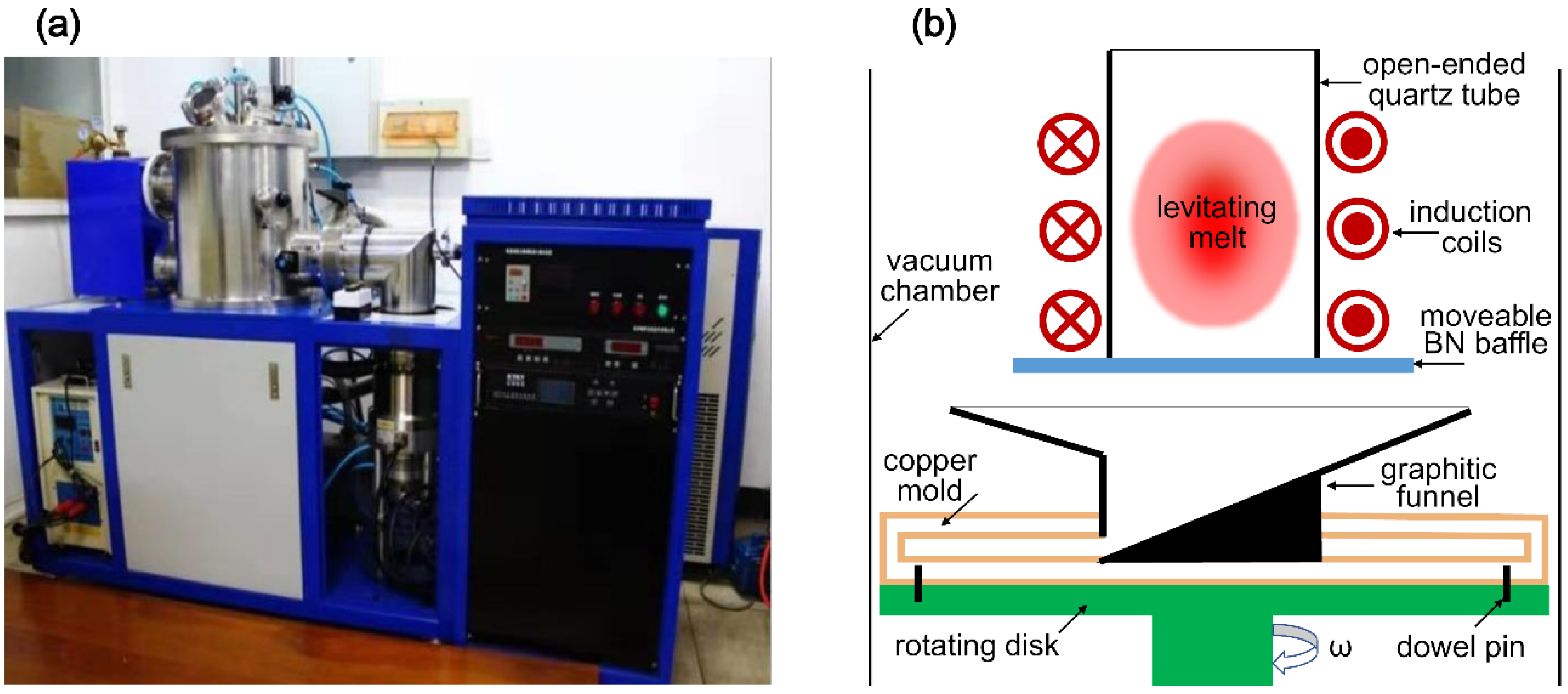


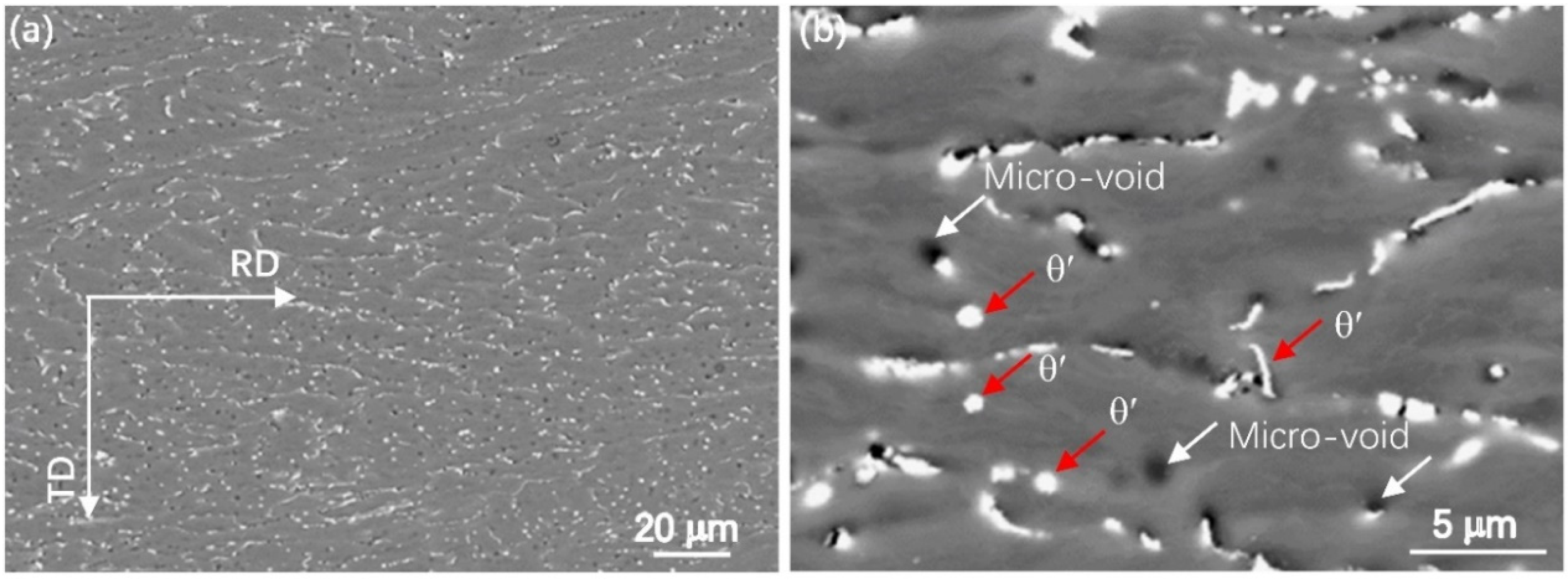
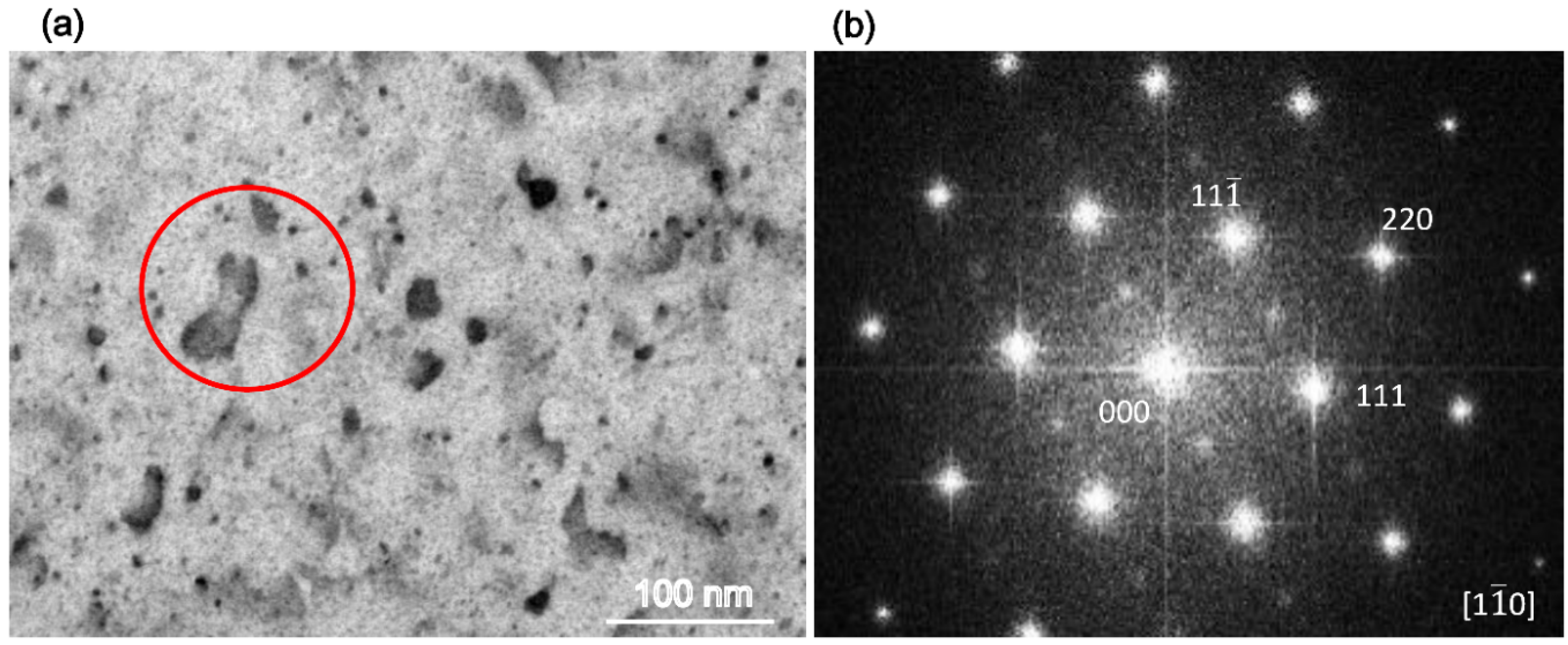
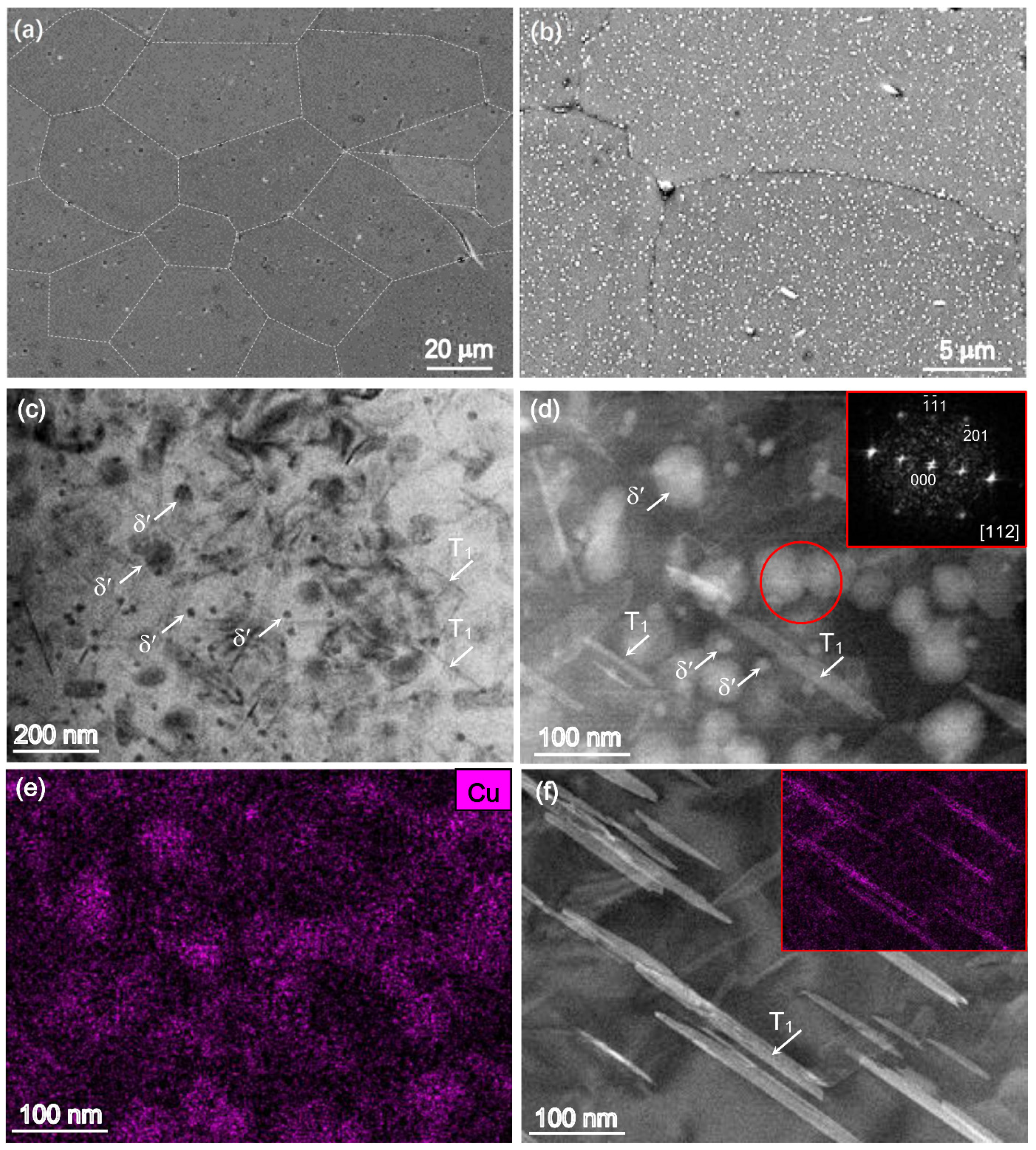
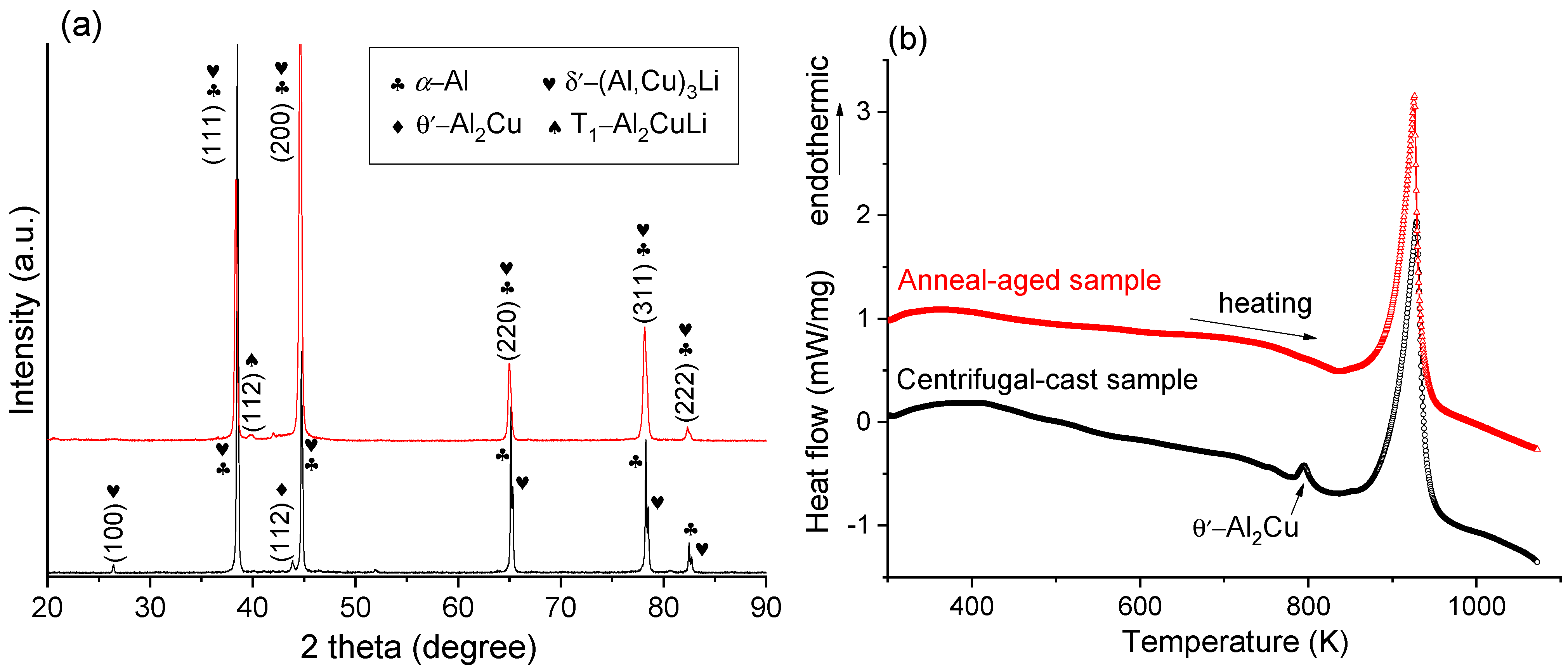
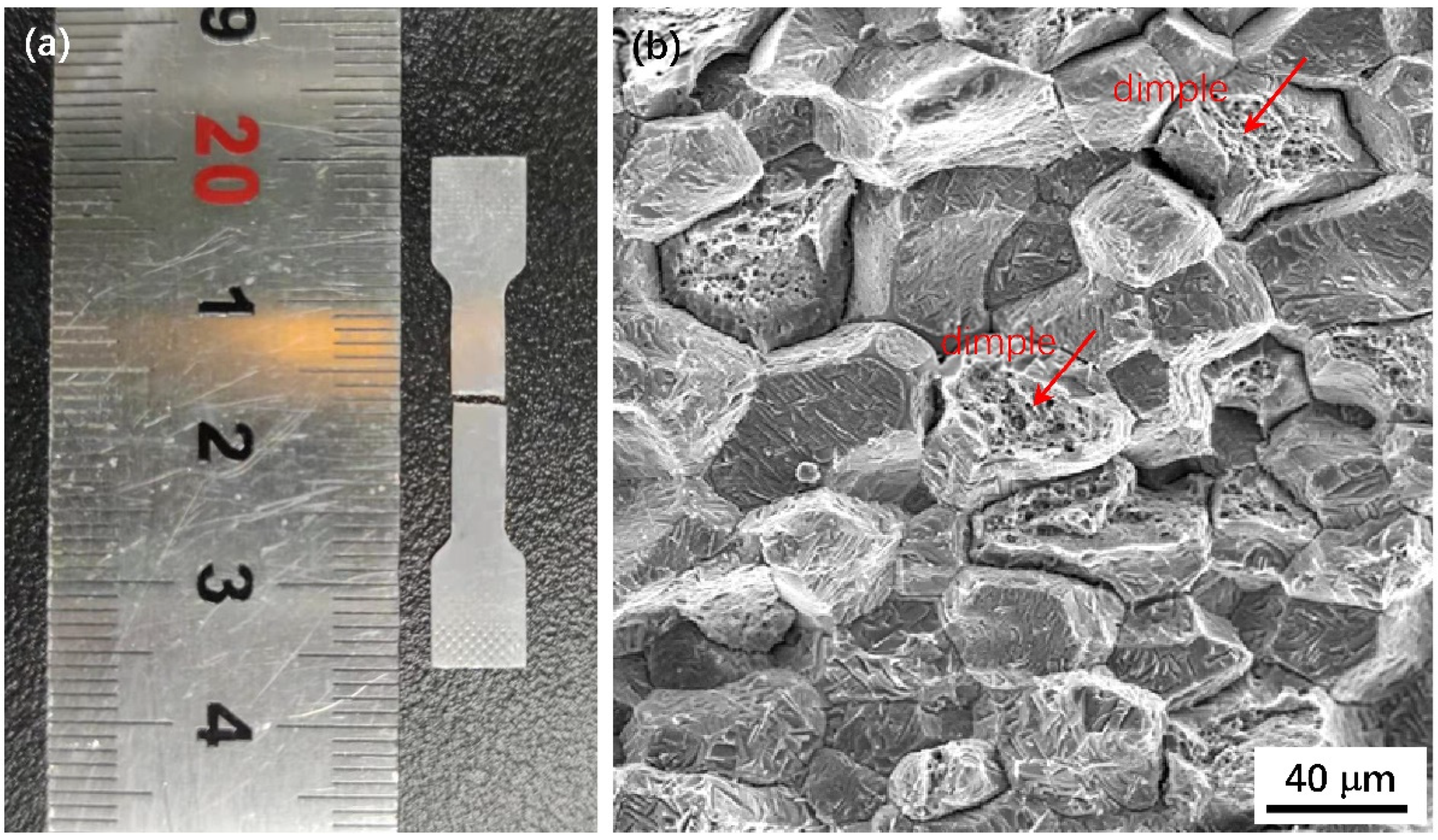
| Cu | Li | Mg | Zn | Mn | Zr | Al |
|---|---|---|---|---|---|---|
| 3.85 | 1.50 | 0.45 | 0.46 | 0.30 | 0.13 | balance |
| UTS (MPa) | YS (MPa) | TEL (%) | |
|---|---|---|---|
| RD specimen | 506 ± 11 | 418 ± 10 | 3.8 ± 0.15 |
| TD specimen | 487 ± 8 | 398 ± 8 | 4.0 ± 0.20 |
| Average value | 496 | 408 | 3.9 |
Publisher’s Note: MDPI stays neutral with regard to jurisdictional claims in published maps and institutional affiliations. |
© 2021 by the authors. Licensee MDPI, Basel, Switzerland. This article is an open access article distributed under the terms and conditions of the Creative Commons Attribution (CC BY) license (https://creativecommons.org/licenses/by/4.0/).
Share and Cite
Tian, Q.; Deng, K.; Xu, Z.; Han, K.; Zheng, H. Microstructural Characterization and Mechanical Property of Al-Li Plate Produced by Centrifugal Casting Method. Metals 2021, 11, 966. https://doi.org/10.3390/met11060966
Tian Q, Deng K, Xu Z, Han K, Zheng H. Microstructural Characterization and Mechanical Property of Al-Li Plate Produced by Centrifugal Casting Method. Metals. 2021; 11(6):966. https://doi.org/10.3390/met11060966
Chicago/Turabian StyleTian, Qingle, Kai Deng, Zhishuai Xu, Ke Han, and Hongxing Zheng. 2021. "Microstructural Characterization and Mechanical Property of Al-Li Plate Produced by Centrifugal Casting Method" Metals 11, no. 6: 966. https://doi.org/10.3390/met11060966
APA StyleTian, Q., Deng, K., Xu, Z., Han, K., & Zheng, H. (2021). Microstructural Characterization and Mechanical Property of Al-Li Plate Produced by Centrifugal Casting Method. Metals, 11(6), 966. https://doi.org/10.3390/met11060966







